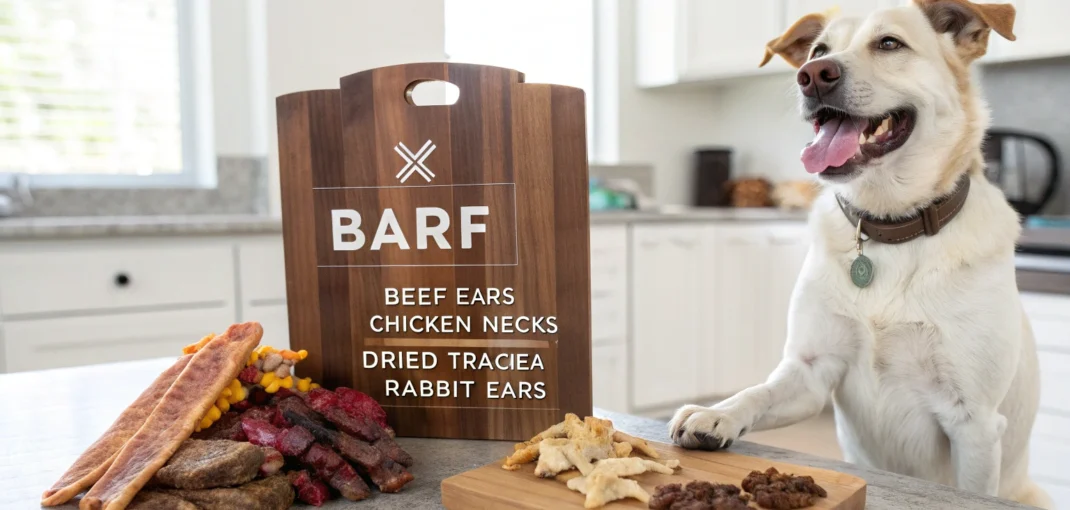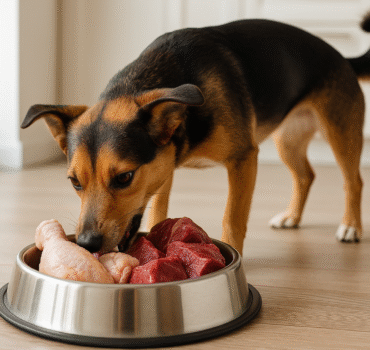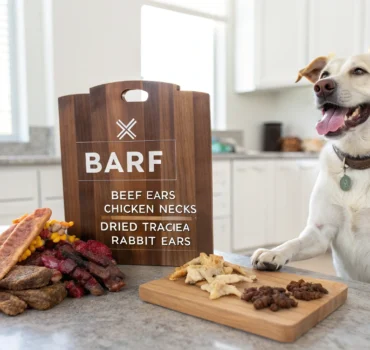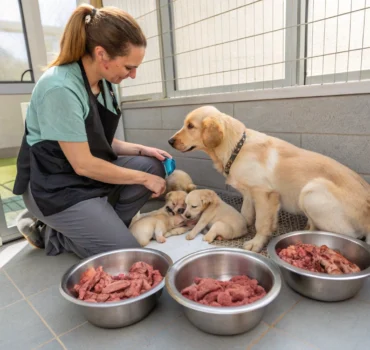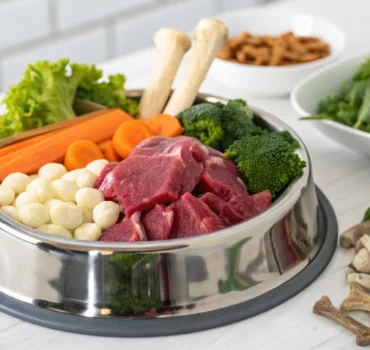The Natural Way to Reward Your Dog Between Meals
If you’re feeding your dog a BARF diet, you’ve already made a great choice for their health. But what about treats?
Many dog owners get confused about treats when they switch to raw feeding. They wonder if they should stick with the old biscuits and processed snacks, or if there’s a better option that fits with their dog’s new diet.
The answer is simple: BARF treats. These natural, raw treats complement your dog’s BARF meals perfectly. They provide the same nutritional benefits as their main diet, without the fillers, chemicals, or processing that come with conventional dog treats.
In this guide, you’ll learn what BARF treats are, why they’re better than processed alternatives, and how to choose the right ones for your dog. Plus, we’ll share some of the best options available for dog owners in Cyprus.
What Are BARF Treats?
BARF treats are natural, minimally processed snacks that align with the Biologically Appropriate Raw Food philosophy. Just like BARF meals, these treats focus on what dogs would naturally eat in the wild.
Unlike conventional dog treats that are baked, extruded, or filled with grains and additives, BARF treats are typically raw or air-dried. They’re made from single ingredients like meat, organs, or bones. No artificial colors, no preservatives, no mystery ingredients.
Think of them as the difference between giving your child a homemade apple slice versus a packaged fruit snack. Both might seem like treats, but one is clearly more nutritious.
Common types of BARF treats include raw meaty bones, dried organs, air-dried meat pieces, and natural chews like ears and trachea. Each type offers different benefits, from dental health to mental stimulation.
The beauty of BARF treats is their simplicity. When you read the ingredient list, you’ll see one word: beef, chicken, rabbit, or whatever the treat is made from. That’s it. That’s how dog treats should be.
Why BARF Treats Are Better Than Processed Dog Treats
Walk down the treat aisle at any pet store and you’ll see hundreds of options. Colorful packages promise everything from fresh breath to joint health. But flip those packages over and read the ingredients. You’ll find a long list of things you can’t pronounce.
BARF treats take a different approach. Here’s why they’re superior:
No Hidden Ingredients: With BARF treats, what you see is what you get. A beef ear is just a beef ear. No fillers, no by-products, no questionable additives.
Better Nutrition: Processed treats are often high in carbohydrates and low in protein. BARF treats are the opposite. They’re protein-rich and provide actual nutritional value, not just empty calories.
Dental Benefits: Many BARF treats, especially raw bones and natural chews, help clean your dog’s teeth naturally. The chewing action scrapes away plaque and tartar better than any dental biscuit.
Digestive Health: Raw and minimally processed treats are easier for dogs to digest. They don’t contain the grains, starches, and binders that can upset sensitive stomachs.
Mental Stimulation: Chewing on a natural treat like a trachea or chicken neck gives your dog something to do. It satisfies their natural chewing instinct and keeps them mentally engaged.
Consistency with Diet: If you’re feeding BARF meals, it makes sense to give BARF treats. You’re not undoing the benefits of raw feeding by introducing processed foods during treat time.
Your dog’s body doesn’t suddenly switch how it processes food just because something is labeled a “treat.” Feed them real food all the time, and they’ll be healthier for it.
Types of BARF Treats and Their Benefits
Not all BARF treats serve the same purpose. Here’s a breakdown of the main categories and what they offer:
Raw Meaty Bones: These include chicken necks, chicken wings, and similar items. They’re excellent for dental health and provide calcium. Perfect for dogs who need something to chew on. At Yummy Dog Food, we offer chicken necks and chicken wings that dogs absolutely love.
Dried Ears: Beef ears, pig ears, and rabbit ears are popular choices. They’re chewy, long-lasting, and great for keeping dogs occupied. Our beef ears and large pig ears are customer favorites. We even carry hairy beef ears and hairy rabbit ears, which provide natural deworming benefits.
Organ Meat Treats: Dried organs like beef lung and beef esophagus are nutrient-dense options. They’re high in protein and packed with vitamins. Check out our beef lung and beef esophagus treats for a healthy snack your dog will devour.
Natural Chews: Items like beef trachea, beef paddywack, and buffalo skin give dogs a satisfying chew experience. Our beef trachea, beef paddywack, and buffalo skin are perfect for dogs who love to chew.
Training Treats: For training, you want something small and quick to eat. Small pieces of dried organ meat or tiny chunks of raw meat work perfectly. They’re high-value rewards that won’t fill your dog up during training sessions.
Each type has its place. Rotate between different BARF treats to keep things interesting and provide a variety of nutrients.
How to Choose the Right BARF Treats for Your Dog
Not every treat works for every dog. Here’s how to pick the best BARF treats for your specific situation:
Consider Size: Small dogs need smaller treats. A chicken neck is perfect for a Chihuahua but might be too small for a German Shepherd. Large dogs can handle bigger chews like beef trachea or large pig ears.
Think About Chewing Style: Aggressive chewers need tougher options like buffalo skin or beef paddywack. Gentle chewers do well with softer options like beef ears or chicken wings.
Watch for Allergies: If your dog has food sensitivities, choose treats made from proteins they tolerate well. Many dogs with chicken allergies do great with beef or rabbit treats.
Match Activity Level: High-energy dogs benefit from longer-lasting chews that keep them busy. Calmer dogs might prefer quicker treats.
Training vs. Recreation: For training, choose small, soft treats that your dog can eat quickly. For entertainment and dental health, go with larger, tougher chews.
Age Matters: Puppies need softer options they can actually chew. Senior dogs with dental issues also benefit from softer treats. Healthy adult dogs can handle the toughest chews.
Start with a variety pack if you’re not sure what your dog will like. Pay attention to which treats they get most excited about and which ones provide the benefits you’re looking for.
Incorporating BARF Treats Into Your Dog’s Routine
BARF treats aren’t just random snacks. They should fit into your dog’s overall nutrition plan. Here’s how to use them effectively:
Training Rewards: Keep small pieces of dried organ meat or raw meat in your treat pouch during training sessions. These high-value rewards motivate dogs better than processed biscuits.
Dental Care: Give your dog a raw meaty bone or natural chew 2-3 times per week. This helps keep their teeth clean between meals. Chicken necks work great for this purpose.
Mental Enrichment: When you need to keep your dog occupied, give them a longer-lasting chew. This is perfect for times when you’re working from home or need them to settle down.
Between Meal Snacks: If your dog gets hungry between meals, a small BARF treat can tide them over. Just remember to account for these calories in their daily food intake.
Supplement Main Meals: Some BARF treats, like organ meats, can supplement your dog’s regular meals. If you’re not including enough organs in their daily food, treats can help fill that gap.
Socialization and Bonding: Giving treats during positive experiences helps build your relationship with your dog. BARF treats make these moments healthier.
Remember that treats should make up no more than 10% of your dog’s daily calorie intake. If you’re giving substantial treats, reduce their main meal slightly to avoid overfeeding.
Safety Tips for Feeding BARF Treats
BARF treats are natural and healthy, but you still need to follow some basic safety guidelines:
Supervise Chewing: Always watch your dog when they’re eating treats, especially bones or large chews. This prevents choking and lets you intervene if needed.
Size Appropriately: Choose treats that match your dog’s size. A treat that’s too small could be a choking hazard. One that’s too large might be frustrating.
Store Properly: Keep raw treats frozen until you’re ready to use them. Dried treats should be stored in a cool, dry place. Check expiration dates and discard anything that looks or smells off.
Introduce Gradually: If your dog is new to BARF treats, start slowly. Their digestive system needs time to adjust, especially if they’ve been eating processed treats for years.
Watch for Reactions: Monitor your dog after introducing new treats. Look for any signs of digestive upset or allergic reactions. Most dogs handle BARF treats beautifully, but it’s always smart to observe.
Clean Up: Raw treats can be messy. Give them in an area that’s easy to clean, or outside if weather permits. Wash your hands after handling raw treats.
Dental Monitoring: While BARF treats are great for teeth, you should still check your dog’s mouth regularly. Look for any broken teeth, excessive wear, or gum problems.
These simple precautions ensure that treat time stays safe and enjoyable for everyone.
Where to Find Quality BARF Treats in Cyprus
Finding high-quality BARF treats can be challenging, especially if you’re new to raw feeding. You want treats that are fresh, properly sourced, and reasonably priced.
At Yummy Dog Food, we specialize in BARF products for Cyprus dog owners. We understand what raw feeders need because we’re raw feeders ourselves.
Our selection includes everything from chicken necks for dental health to beef trachea for serious chewers. We carry unique options like hairy rabbit ears that provide natural deworming benefits.
All our treats are carefully sourced and stored properly to maintain freshness. We offer competitive prices, with most treats ranging from €3.65 to €6.50. That’s affordable nutrition without compromising on quality.
Whether you need training treats, dental chews, or just something to keep your dog happy, we’ve got you covered. Browse our full selection online and have treats delivered right to your door anywhere in Cyprus.
Conclusion: Treat Your Dog to Real Food
Switching to BARF treats is a natural extension of feeding a raw diet. Why give your dog processed junk as rewards when you can offer real, nutritious food instead?
BARF treats provide better nutrition, support dental health, and keep your dog mentally stimulated. They’re what treats should be: simple, natural, and beneficial.
Your dog doesn’t know the difference between a meal and a treat. They just know they’re eating. Make every bite count by choosing foods that support their health rather than undermine it.
Ready to upgrade your dog’s treat game? Visit Yummy Dog Food and explore our complete selection of BARF treats. From beef ears to chicken wings, we have everything you need to keep your dog happy and healthy. Order today and see the difference real food makes.
Frequently Asked Questions
Are BARF treats safe for puppies?
Yes, puppies can enjoy BARF treats, but choose age-appropriate options. Softer treats like chicken necks or small pieces of beef lung work well for young puppies. Avoid very hard chews until their adult teeth come in. Always supervise puppies with any treat, and introduce new items gradually to avoid digestive upset.
How long do BARF treats last?
Storage life depends on the type of treat. Raw treats like chicken necks should be kept frozen and used within a few months. Dried treats like beef ears, trachea, and organs can last 6-12 months when stored in a cool, dry place in a sealed container. Always check for any signs of spoilage before giving treats to your dog.
Can I give BARF treats if my dog eats kibble?
Absolutely! Even if you’re not ready to switch to a full BARF diet, you can still give BARF treats. They’re a great way to add natural nutrition to your dog’s diet. Just introduce them gradually, especially if your dog has only eaten processed food. Many dog owners start with BARF treats and eventually transition to complete raw feeding once they see the benefits.
